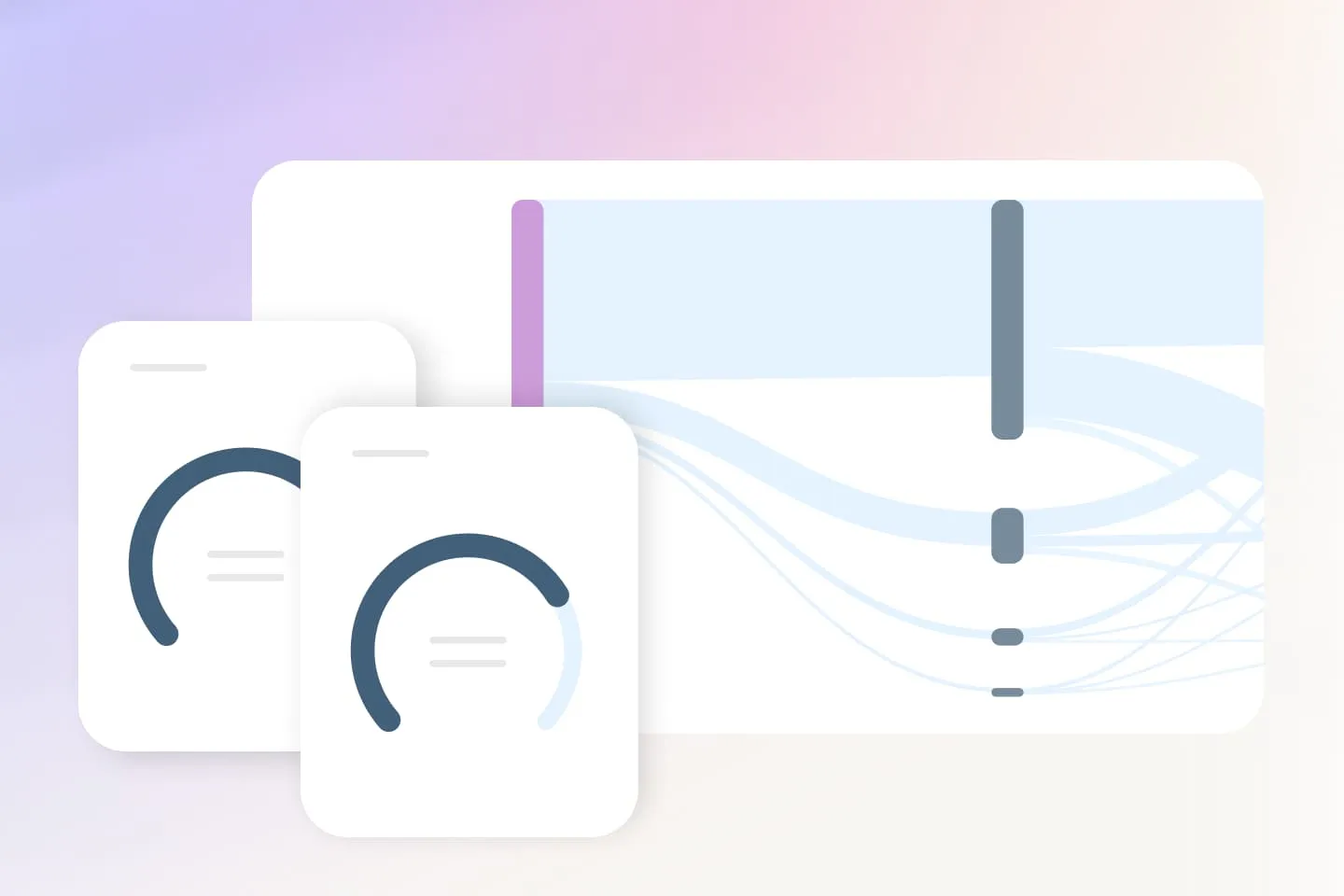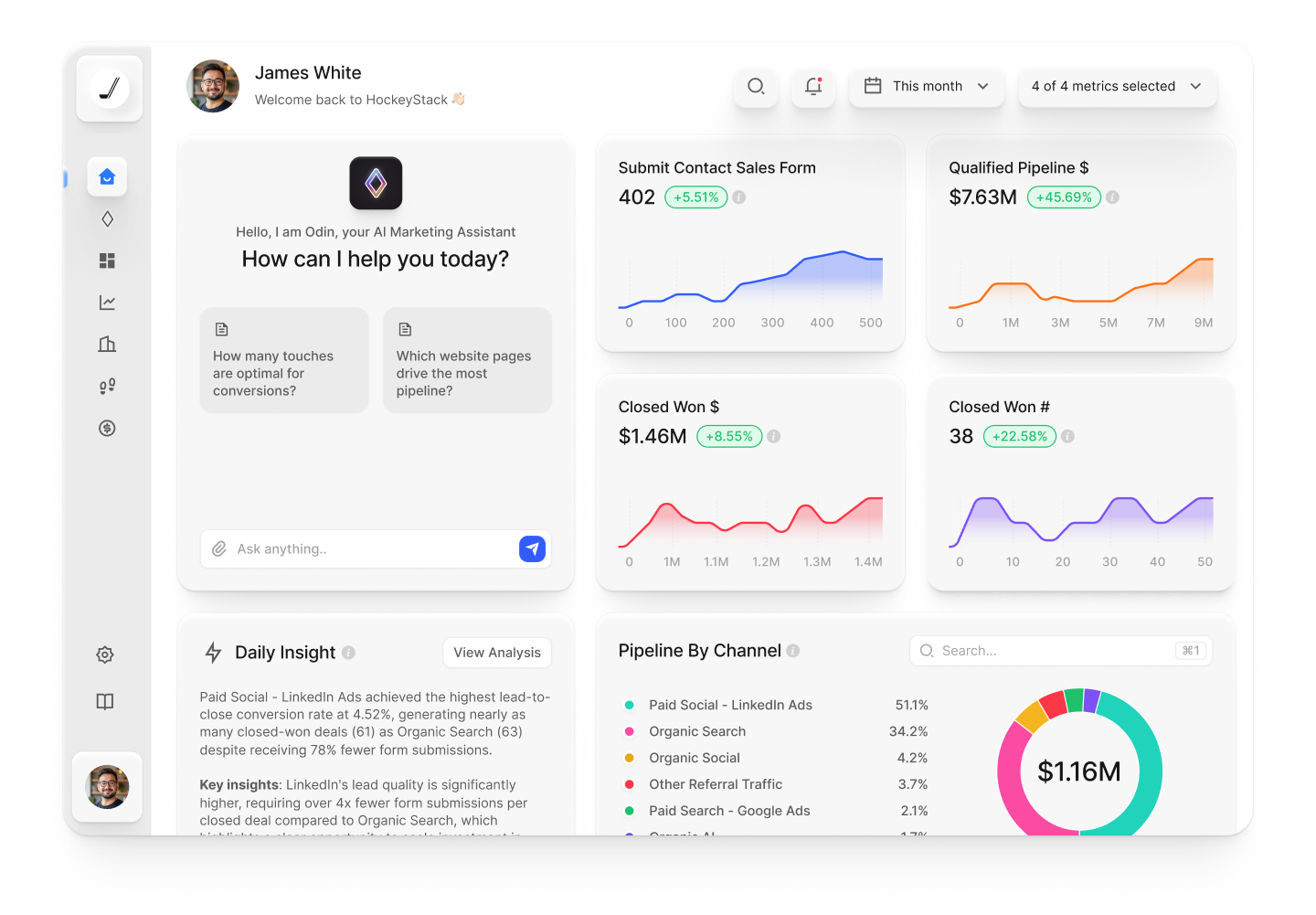GTM AI Strategies for SaaS: The New Standard for Predictable Growth

GTM AI Strategies for SaaS: The New Standard for Predictable Growth
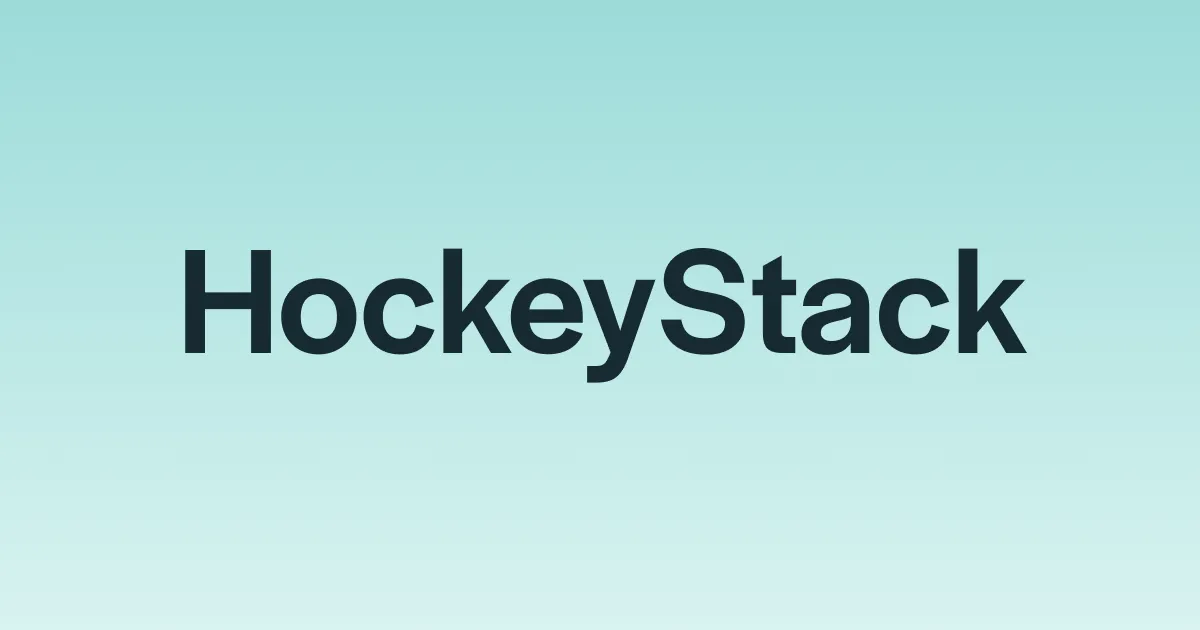
There's a moment in every SaaS company's growth when the wheels start to come off. The GTM playbook that got you to your first 500 customers stops working.
You hire more reps, they take longer to ramp, and somehow close fewer deals. Your simple value prop splinters into a dozen different pitches depending on who's selling.
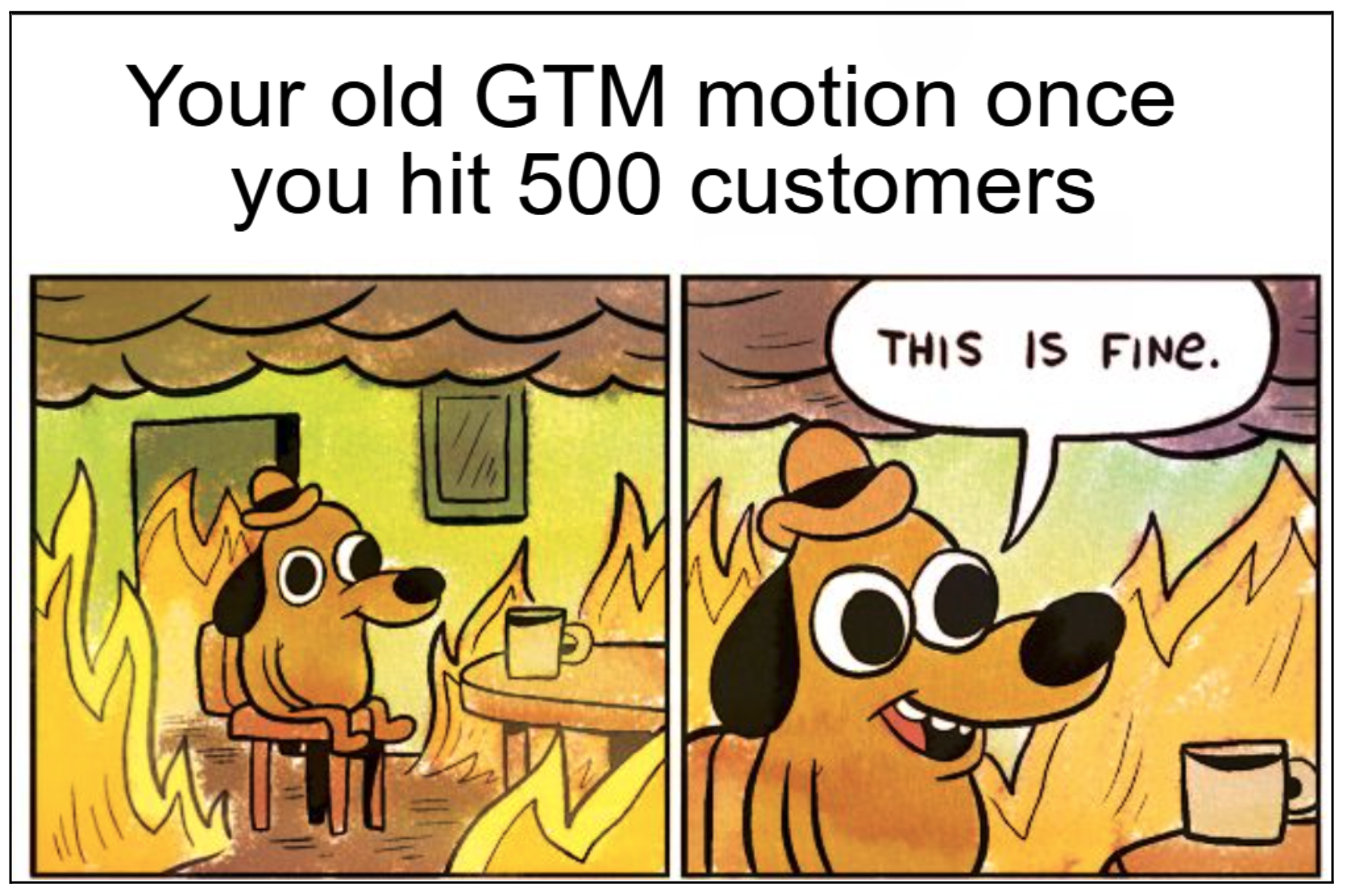
Your go-to-market motion now involves so many variables, touchpoints, and decisions that no amount of spreadsheets or Monday morning meetings can keep it running smoothly.
The companies breaking through this wall are using AI to rebuild their GTM strategies.
Not as a band-aid, but as the core system that analyzes millions of signals, automates the mundane tasks, coordinates complex workflows, and tells your team exactly where to focus.
Below, we’ll break down how to implement these AI strategies in your own GTM motion, without ripping out your entire tech stack.
What is a GTM AI Strategy for SaaS?
Most SaaS companies think they have an AI strategy because they bought a few tools with "AI-powered" in the description.
But usually, it's an AI SDR that just spams prospects, a lead scoring model from 2019, and a dashboard with "predictive" analytics that predict nothing useful.
Meanwhile, revenue teams are still stuck with the same broken processes:
- Marketing nurtures leads who downloaded an ebook two years ago, while today's buyers evaluate you without you knowing
- Sales jump on every demo request equally, though most buyers have already made their decision before they booked
- Customer success scrambles to save accounts after usage drops to zero when they should have spotted warning signs months earlier
- Product tracks feature adoption, sales tracks pipeline, but nobody connects the dots between how customers use your product and what they'll buy next
This is the difference between buying AI tools and building an AI strategy. Tools are band-aids on broken processes. A strategy rebuilds how your entire revenue engine works.
A GTM AI strategy for SaaS means building an intelligent system that connects all your revenue data, outlines patterns, anticipates customer behavior, and orchestrates coordinated actions across every team.
The key difference is that AI stops optimizing individual tasks in isolation and treats your entire revenue operation as one interconnected system where every signal influences every decision.
Here’s exactly what it brings:
- Real-time account intelligence: AI tracks 1,000+ behavioral signals across product usage, marketing engagement, and sales interactions to find buying intent before competitors even know the account exists. It tells you which trial users are ready to convert and which customers are primed for expansion.
- Intelligent process automation: Your team stops drowning in manual tasks like updating Salesforce, scheduling follow-ups, and building reports. AI handles the operational burden automatically, so reps can spend more time on meaningful conversations and close deals.
- Connected revenue operations: Marketing, sales, product, and customer success finally operate from the same playbook. When product usage signals an upsell opportunity, sales get notifications with full context. When marketing notices a high-intent account, the right rep knows instantly.
For example, AI might notice that customers who bring 5+ team members and use your analytics feature convert to paid plans at 3x the normal rate.
It automatically assigns these accounts to senior reps, launches the enterprise onboarding sequence, and schedules a value review call for day 14.
3 GTM AI Strategies Every SaaS Company Needs to Master
Now let's get tactical. These three core strategies form the foundation of any successful AI-powered GTM motion for SaaS.
Master these, and you'll completely rebuild how you acquire, convert, and expand your customer base:
Strategy #1: For Acquisition (Find Your Best-Fit Customers Before They Find You)
The average B2B buyer spends 70% of their journey researching anonymously before reaching out to sales. That means you're missing most of your pipeline because you can't see who's interested.
AI identifies these invisible buyers and helps you engage them before competitors realize they're in the market.
Build a Predictive Model of Your ICP
The old way: Companies manually analyze their best customers and look for patterns in demographics and firmographics. They build static personas based on job titles, company size, and industry, then hope these criteria predict future success.
Here's how one Redditor describes their process:
"We went through our list of active clients and scanned their job descriptions. That told us which people tend to use our tools the most. Then we searched for those specific people on social media and found out more about them. We looked for similarities and built up personas that way."
This manual approach might have worked five years ago, but it misses the subtle signals that show someone's in-market.
The AI way: AI examines your customers to understand what makes the best ones different. It tracks how they use your product, what features they touch, and when they reach out for help. The system updates every day with new data, so your ICP stays accurate as your business changes.
How to implement:
- Export your customer data with metrics like revenue, lifetime value, and churn dates so AI can learn what your best customers look like
- Use AI-powered enrichment tools to automatically insert behavioral and technographic data into your CRM
- Build an AI scoring system that prioritizes actions over attributes (what companies do matters more than their size or industry)
- Set up alerts that notify reps the moment a high-fit account shows interest so they can reach out while the buyer is engaged
Example: The model shows that your most successful customers use Salesforce, have remote teams across 3+ time zones, and search for "automation" on your site before signing up. Your marketing team now knows exactly which keywords to target and which integration partners matter most.
Identify In-Market Accounts Showing Real-Time Intent
The old way: Sales teams wait for prospects to fill out forms or request demos, and then treat every inbound lead the same way. They miss the buyers who research anonymously for weeks before reaching out, if they even reach out at all.
The AI way: AI monitors thousands of buying signals across first-party and third-party data to see which accounts are actively evaluating solutions.
It tracks anonymous website visitors, correlates them with other behaviors, and alerts your team the moment an account shows serious interest. Speed is everything here, as one Reddit user explained:
"Buyer intent signals are gold—website visits, LinkedIn engagement, intent data, all tell you who's ready. The trick? Act fast and strike while the iron is hot. It's a game-changer for conversions."
AI makes this speed and scale possible. The system knows the difference between casual browsers and serious buyers, so reps only get alerts about real opportunities.
How to implement:
- Set up AI-powered lead scoring in your CRM that combines website behavior with firmographic data to rank accounts
- Use ChatGPT or Claude APIs to write personalized outreach based on the specific pages an account visited
- Set up automated alerts that fire when accounts combine multiple buying signals like repeat visits + content downloads
- Test AI-driven chat tools that interact with high-intent visitors differently than casual browsers based on their behavior
Example: An account you've never heard of visits your pricing page 3x this week, reads five case studies, and has employees checking out your LinkedIn posts. AI identifies the company, enriches it with firmographic data, scores it as high-intent, and alerts the right rep with a personalized outreach strategy. The rep reaches out while the buyer is still evaluating, not after they've chosen a competitor.
Optimize Your Ad Spend with Surgical Precision
The old way: Marketing teams spray their budget across channels and hope something sticks. They optimize for clicks and impressions while having no idea if they're reaching accounts that could actually buy. Many B2B marketers have given up on paid ads entirely. As one user put it:
"Spend the money on something clever to hand out at the event. Google Ads isn't good at this, nor is it likely to be."
This frustration makes sense when you're targeting broad audiences instead of specific accounts ready to buy.
The AI way: AI analyzes which accounts are worth targeting before you spend a dollar on them. It outlines high-fit companies, and then automatically optimizes your campaigns to reach these specific accounts across channels. Your budget goes only to accounts that match your ICP and show intent, not random people who clicked an ad once.
How to implement:
- Upload your ICP and target account list to your ad platforms so campaigns focus on companies that fit your criteria
- Set up conversion tracking that connects ad clicks to actual pipeline and revenue, not just form fills
- Create custom audiences based on intent data and website visitors to retarget accounts already researching you
- Build exclusion lists of bad-fit companies, competitors, and existing customers to stop wasting money on dead ends
- Test account-based advertising on your top 100 target accounts before expanding to broader audiences
How to implement:
- Use AI tools like ChatGPT or Claude to generate multiple ad variations based on your ICP's pain points and test them
- Set up AI-enhanced attribution tools that track multi-touch journeys instead of giving all credit to the last click
- Create automated rules that pause campaigns when the cost per opportunity exceeds your thresholds
- Use AI to analyze which combinations of targeting criteria produce the best pipeline and double down on those
💡PRO TIP: This whole predictive targeting process runs automatically in HockeyStack. Odin AI builds your predictive ICP from historical data, finds matching accounts with buying intent, while our GTM workflows automatically sync those audiences to your ad platforms. You get advanced ad targeting without the manual work of building and updating lists every week.
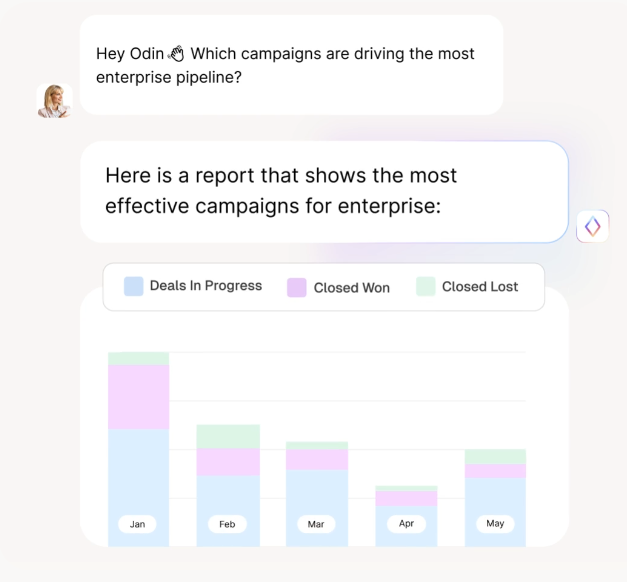
Strategy #2: For Activation & Conversion (Turn Product Users into Pipeline)
Most SaaS companies treat their trial users like a black box — they sign up, poke around for a few days, and either convert or disappear without explanation.
On the other hand, GTM AI watches how people use your product and tells you who's about to convert, who needs help, and who's wasting your time.
Identify Product-Qualified Leads (PQLs)
The old way: Your sales team probably calls everyone who starts a trial, even though most signed up just to see what you're about. You track logins and feature usage, but those metrics tell you nothing about who's got budget and urgency.
The AI way: AI defines what a PQL means for your specific product. Not generic rules like "used 3 features," but the exact behaviors that mean someone's ready for a sales conversation. Maybe it's users who run their first campaign, hit a usage limit, or search your knowledge base for "enterprise features."
AI makes this process automatic, but a Reddit user broke down what's happening under the hood:
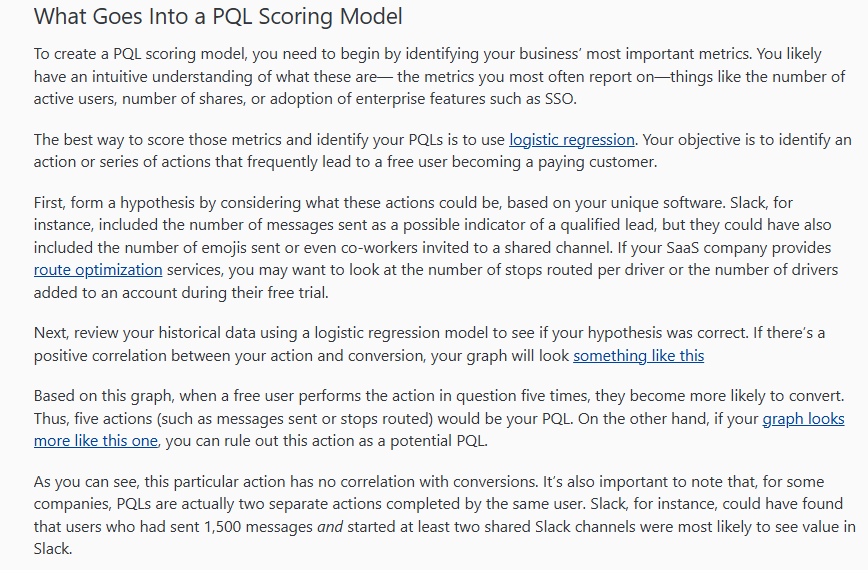
How to implement:
- Train the system on your closed-won deals and dead trials so it knows the difference between testing and buying
- Set up AI alerts for when users do things that lead to purchase, whether that's adding teammates or hitting rate limits
- Use AI tools to group PQLs by what they need next (technical users get engineering help, decision makers get ROI conversations)
- Run experiments where AI creates new PQL rules based on recent conversions, then see if those predictions hold up
Example: A developer signs up and goes straight to your API docs. They test three endpoints, check rate limits, and read your SLA. AI knows this behavior means they're evaluating technical feasibility for their team. The rep gets an alert to skip the demo and send integration guides instead.
Trigger Behavior-Based Outreach
The old way: Your SDRs send the same three-email sequence to everyone who downloads a whitepaper, regardless of what they did next. They follow up on day 3, day 7, and day 14 with increasingly desperate "just checking in" messages that everyone ignores.
The AI way: AI watches what users do after each touchpoint and adjusts the entire outreach strategy based on their response. It knows when someone opens every email but never clicks (send a different angle), when they forward emails internally (loop in decision makers), or when they go dark after viewing pricing (mention budget concerns). One Reddit user explained why timing and context matter more than volume:
"Honestly, most intent signals are noise until you tie them to actual behavior. Job changes, though? That one's gold. Every time someone lands a new growth or marketing role, there's a short window where they're actively looking to shake things up.
I usually just send a simple congrats, maybe reference what they posted if they're active, and 8 times out of 10 it turns into a real convo."
How to implement:
- Feed AI your CRM history so it understands which sequences work for which types of prospects and behaviors
- Build triggers for specific behavior combinations, like when someone reads your case study, then checks competitor comparison pages
- Use AI to find the perfect send time for each prospect based on when they typically open emails and visit your site
- Create automated plays for common patterns like trial users who stop logging in after day 3 or prospects who ghost after pricing calls
Example: Your champion goes dark after saying they need "internal alignment." AI sees three new people from their company checking your pricing page. The system automatically sends your champion customer references from similar companies while preparing multi-threaded outreach to the new stakeholders.
💡PRO TIP: HockeyStack's GTM Workflows make this automatic. When someone hits a PQL signal in your product, workflows instantly create CRM tasks and feed Nova AI the full context — what features they used, their engagement history, and their company info. Nova then helps reps write personalized outreach that references their exact use case, not generic templates.
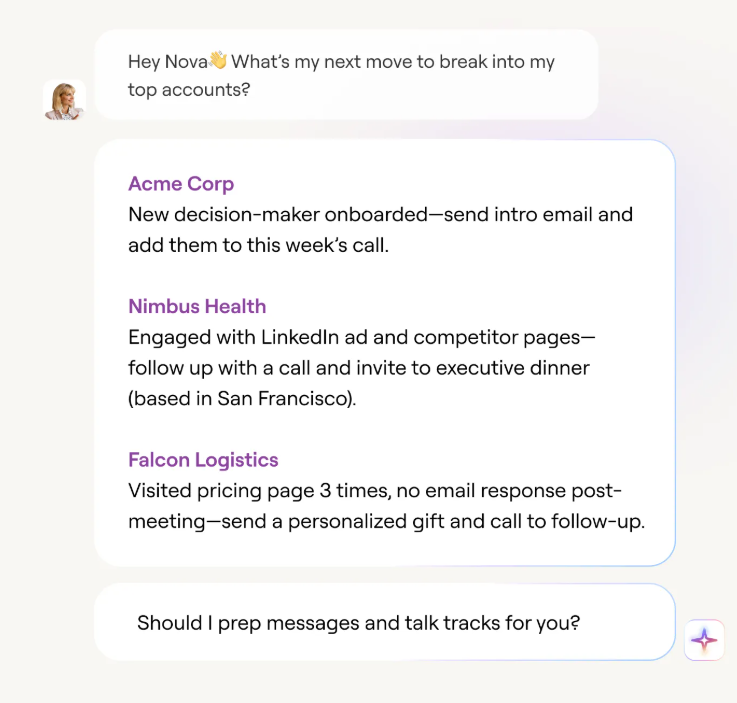
Deliver Personalized Onboarding Journeys
The old way: Every user gets the same generic welcome email, the same five-step tutorial, and the same check-in call on day seven. Half your users are bored because they already know the basics, while the other half are lost because you moved too fast.
The AI way: AI watches how each user learns and adapts the onboarding in real time. Power users skip straight to advanced features while beginners get extra handholding.
The system knows when someone's stuck before they know it themselves and serves up the exact help they need. One Reddit user shared an interesting approach on how their team is using AI for onboarding:
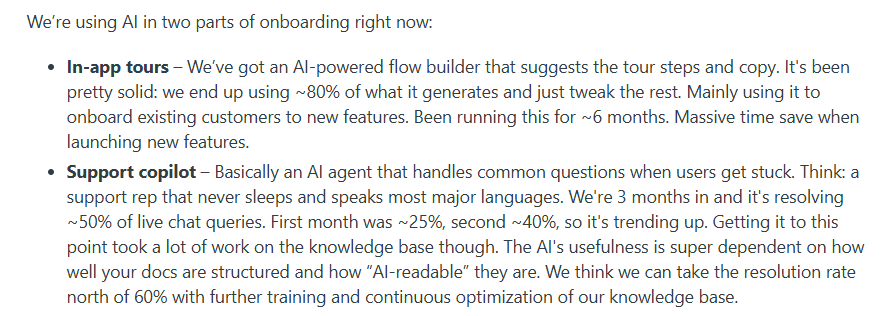
How to implement:
- Use AI to analyze successful user journeys and build different onboarding paths for different user segments
- Set up AI chatbots that answer setup questions instantly instead of making users wait for support tickets
- Create dynamic product tours that skip steps users have already completed and focus on features they haven't discovered
- Let AI personalize onboarding emails based on what features each user touched and where they spent the most time
- Track completion rates for each onboarding step and use AI to test new approaches for the biggest drop-off points
Example: A new user imports 50,000 records on day one. AI recognizes this as an enterprise pattern and swaps out the basic onboarding for advanced training on bulk operations, automation rules, and team permissions. The user gets a dedicated Slack channel and direct access to your solutions team instead of generic help articles.
Strategy #3: For Retention & Expansion (Turn Your Customer Base into Your Biggest Growth Engine)
Your existing customers should be your fastest path to growth, but most SaaS companies treat them like a subscription that runs on autopilot until it churns.
With AI, you can spot expansion opportunities and churn risks weeks before they happen, so you can act while there's still time to influence the outcome.
Predict and Prevent Customer Churn
The old way: You find out customers are leaving when they cancel their subscription or don't renew. Your team scrambles to save them with desperate discount offers, but by then, they've already moved to a competitor.
The AI way: Your customers start leaving long before they cancel. AI sees it happening through slower logins, angry support tickets, and expired credit cards, but they don't bother updating.
It tells you who's at risk and why, so you can save them before they're gone. Some people still doubt AI can predict churn, while one Reddit user argued you need massive datasets:
“Unless you have a vast amount of data points about your customers, and you have at least 500k of those customers, then maybe AI can predict which customers are likely to churn... but you could also hire a statistician and find segments and factors that highly correlate.”
But modern AI works well even with much smaller datasets. You don't need 500k customers anymore. AI can find churn patterns with just a few hundred accounts by combining multiple data sources and using advanced techniques that weren't available even two years ago.
How to implement:
- Train AI on your usage data, support tickets, and billing history so it learns what happens before customers typically cancel
- Create early warning alerts for behavior changes like key users stopping logins or usage dropping 30% month-over-month
- Set up AI monitoring for competitive threats, like customers researching alternatives or asking about exports
- Track feature adoption patterns and let AI flag accounts that never reach the "sticky" threshold your successful customers hit
Example: A customer's usage drops 40% after their power user leaves the company. AI spots this pattern and alerts your CS team with a specific save play to offer free training for the new admin and share templates from similar companies. You save the account before they start to consider alternatives.
Identify Your Best Upsell Opportunities
The old way: Your sales team waits for customers to ask about upgrading or relies on annual reviews to pitch higher tiers. They miss the perfect moment when customers do need more because nobody's watching for the signals.
The AI way: AI tools can track the breadcrumbs customers leave before they upgrade. They start hitting rate limits, their usage patterns change, and they ask support about features they don't have. The system scores every account for expansion potential and tells you which ones to call today with which specific offer.
How to implement:
- Monitor usage trends so you know when accounts will hit their limits in the next 30 days
- Build alerts for expansion signals, like new departments joining or usage spreading across teams
- Use AI to match customers with the right upgrade path based on how similar accounts expanded
- Track feature exploration to spot when users repeatedly try to access premium functionality
Example: A customer starts inviting users from three new departments, and their API calls triple in a week. AI recognizes this growth pattern and alerts the account manager that they'll hit their plan limits in 12 days. The rep reaches out with a custom enterprise proposal before the customer experiences any disruption.
💡PRO TIP: Set this up once in HockeyStack and never miss an upsell again. GTM Workflows detect expansion signals, then automatically launch email campaigns that outline relevant upgrade benefits to key stakeholders. Your account managers get alerts with perfect timing, after marketing warms up the account but before they hit any limits.
Learn more → How to Actually Integrate AI into Your Existing GTM Workflows
Automate QBR Prep and Business Reviews
The old way: Your CSMs spend days before each QBR pulling data from ten different tools, building slide decks, and calculating ROI metrics manually. Half the meeting covers what happened last quarter, and there’s no planning for what comes next.
The AI way: AI automatically generates QBR decks with all the metrics, insights, and recommendations ready to go. It pulls together usage trends, calculates value delivered, spots problems brewing, and writes recommendations for the next quarter.
How to implement:
- Use AI to pull usage data, support tickets, and engagement metrics into automated QBR templates that update before each meeting
- Build AI summaries that explain what changed since the last review, why it matters, and what actions the customer should take next
- Let AI analyze similar customers to recommend features, integrations, or workflows this account hasn't discovered yet, but would benefit from
- Set up automated pre-meeting briefs that tell CSMs exactly what to focus on, what to avoid, and what the customer will probably ask about
Example: A customer's renewal is in 60 days. AI automatically builds a deck showing they've saved 400 hours this quarter, their team adoption grew 30%, but their power users are stuck on manual workflows. It recommends pushing the automation features and includes three case studies from similar companies. The CSM tweaks the narrative and walks in confidently.
5 Common Mistakes SaaS Companies Make with GTM AI
Most SaaS companies stumble in the same places with GTM AI. These mistakes are common enough that you can avoid them if you know what to look for:
- They leave product data out of the AI equation: Teams feed AI their Salesforce data and marketing metrics, but forget the goldmine sitting in their product analytics. Usage patterns predict renewals and expansions better than any other signal, yet they're rarely part of the model.
- They buy ten different AI point solutions: Marketing gets an email automation tool, sales buys conversation intelligence, and customer success picks up a health scoring platform. Now you have ten tools that connect to each other and still can't answer "what's happening with this account?"
- They pour everything into new customer acquisition: The average cost to acquire new customers is 4–5x higher than the cost to retain current ones. Yet, teams spend their entire AI budget on lead scoring and cold outreach while their existing customers churn and expansion opportunities go unnoticed.
- Automating a broken customer experience: If your trial experience loses 80% of users, AI won't magically fix that. It just helps you lose them faster and on a greater scale. Fix what's broken first, and then automate what works.
- They forget that SaaS sales are still relationship-driven. Your AEs and CSMs worry AI will reduce them to order-takers. They resist using it, ignore its recommendations, and the whole investment fails because the people supposed to benefit won't adopt it.
How to Choose the Right GTM AI Platform for Your SaaS Business
Every vendor promises "AI-powered" features, but most are built for one-and-done enterprise deals. SaaS is different.
Your customers spend time in your product every day, and their behavior tells you everything about whether they'll expand, churn, or become your advocates.
Here's what to look for when evaluating platforms for SaaS:
- It must support SaaS-specific AI models: Generic lead scoring won't cut it when your business runs on monthly recurring revenue. You need models that understand PQLs from product behavior, predict churn from usage patterns, and spot expansion signals.
- It must connect product data with your GTM data: This is non-negotiable. If a platform can't pull in product analytics and combine it with your CRM and marketing data, it won't work for SaaS. You need to track everything from the first website visit through product usage to upsell revenue in one place.
- It needs a flexible, behavior-driven workflow engine: Most automation triggers on email opens or form fills, but SaaS buying signals happen inside your product. When a trial user invites their team or hits usage limits, the platform should automatically alert sales and start the right nurture sequence.
- It must be designed for fast time-to-value. If implementation takes six months and needs a team of engineers, your competition will eat your lunch while you're still onboarding. Look for platforms that can connect to your tools in hours and provide the first batch of insights within the first few days.
- It needs to learn from your wins and losses: The best platforms improve their predictions over time by analyzing which alerts led to closed deals and which ones were false positives. If the AI isn't getting smarter based on your actual outcomes, you're stuck with static rules that decay over time.
The Unified GTM AI Platform Built for B2B SaaS
You bought AI to fix your GTM, but it doesn't speak SaaS — it can't connect product signals to revenue outcomes, coordinate plays across the customer lifecycle, or tell you why one account expands while similar ones churn.
That's where HockeyStack comes in.
HockeyStack is an end-to-end GTM AI platform that pulls together every revenue signal from first touch to expansion, uses dual AI agents for analysis and execution, and runs automated workflows that coordinate your entire revenue team's actions.
Here's why HockeyStack succeeds where other GTM AI platforms fall short:
- Odin AI answers your revenue questions instantly in plain English: Ask which campaigns drive enterprise accounts or why trial conversions dipped last month — Odin analyzes your entire funnel and brings visual insights in seconds. No more waiting for custom reports or piecing together data from multiple dashboards to understand what's happening in your SaaS metrics.
- Nova AI automates your entire GTM execution: Nova researches accounts, scores leads based on product usage, and runs workflows across your tools automatically. When someone hits usage limits or explores premium features, Nova enriches their data, finds the right contacts, and triggers personalized outreach.
- Unified revenue intelligence: You can integrate data from CRM, marketing automation, ad platforms, and product analytics in one real-time view. Your teams finally agree on metrics because they're all looking at the same account intelligence and attribution data across the entire customer lifecycle.
- Multi-touch attribution that proves what drives recurring revenue: Choose from nine attribution models to see how each touchpoint impacts pipeline and MRR. Track the complete journey from first visit to renewal, compare models side-by-side, and know which campaigns deserve more budget based on real subscription growth.
- Automated workflows that turn product signals into pipeline: When AI spots intent, like trial users hitting limits, accounts exploring enterprise features, customers adding seats, it launches workflows instantly. The system updates your CRM, starts personalized sequences, and coordinates every team's response automatically, so no opportunity slips through.
Play with our interactive demo to see how easy HockeyStack can unify your data, automate your GTM plays, and drive real MRR growth from day one.
FAQs
How is a GTM AI Platform different from a Product-Led Growth (PLG) tool?
PLG tools track product usage and send automated emails when users hit certain milestones. On the other hand, a GTM AI platform connects your entire revenue operation, including product data, marketing campaigns, sales activities, and customer success metrics.
While PLG tools help you spot engaged users, GTM AI platforms coordinate what happens next across every team. They score leads, route them to reps, launch campaigns, and predict which accounts will convert.
Key difference: PLG tools are a single piece of your stack, while GTM AI platforms like HockeyStack make your entire stack work together.
How much product usage data do we need to get started with this?
You don't need years of historical data to start seeing value. Most SaaS companies can get meaningful insights with just 3-6 months of product usage data.
The sooner you connect your product data to your GTM engine, the faster the AI will learn and the more powerful its insights will become.
How can AI specifically help improve our free-to-paid conversion rate?
AI monitors what your best customers did during their trials and outlines the patterns that predict conversion.
It spots when free users show similar behaviors and automatically adjusts their experience with targeted onboarding, timely nudges toward key features, and personalized outreach when they're most likely to buy.
Is this only useful for self-serve, PLG companies?
Not at all. Sales-led SaaS companies use GTM AI to prioritize demo requests, score enterprise leads based on engagement, and coordinate complex multi-threaded deals.
The platform helps sales teams know which prospects are worth pursuing, what message will resonate, and when decision-makers are actually ready to buy.
Whether you're PLG, sales-led, or hybrid, GTM AI works because every SaaS business runs into the same problem of connecting customer signals to revenue actions.
13 Ways to Leverage Intent Data for B2B Sales
Want to know which prospects are actually ready to buy? Here are 13 ways to use intent data to find your hottest B2B leads and close more deals.

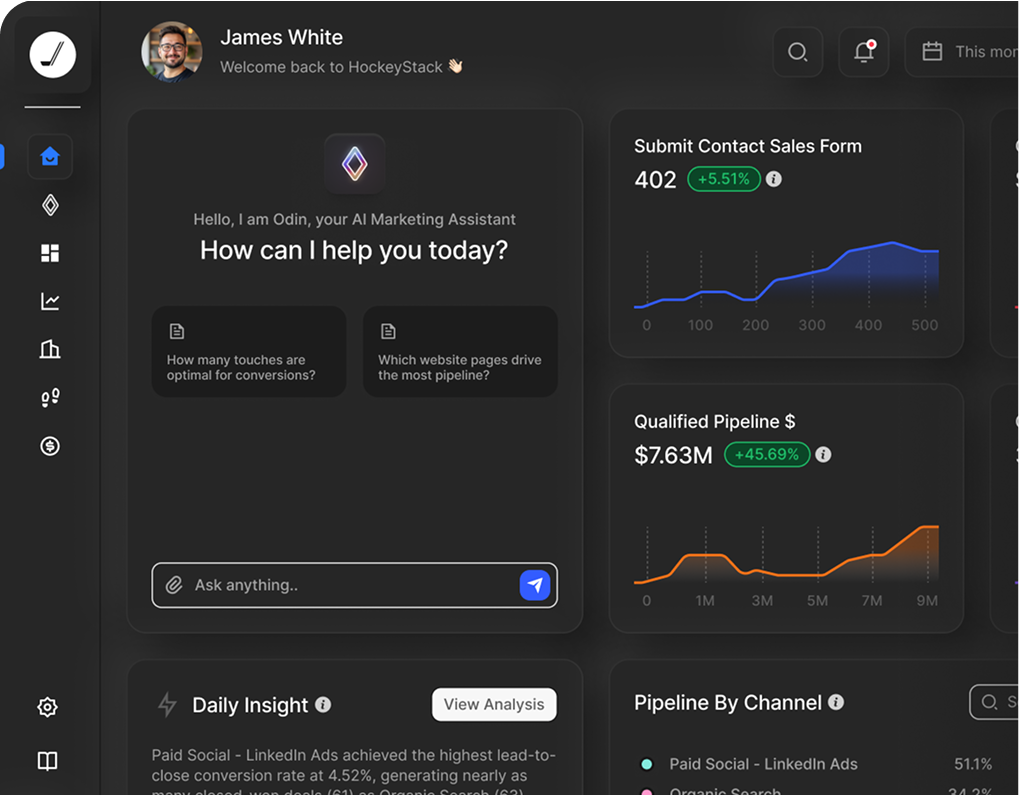
Ready to see HockeyStack in action?
HockeyStack turns all of your online and offline GTM data into visual buyer journeys and dashboards, AI-powered recommendations, and the industry’s best-performing account and lead scoring.
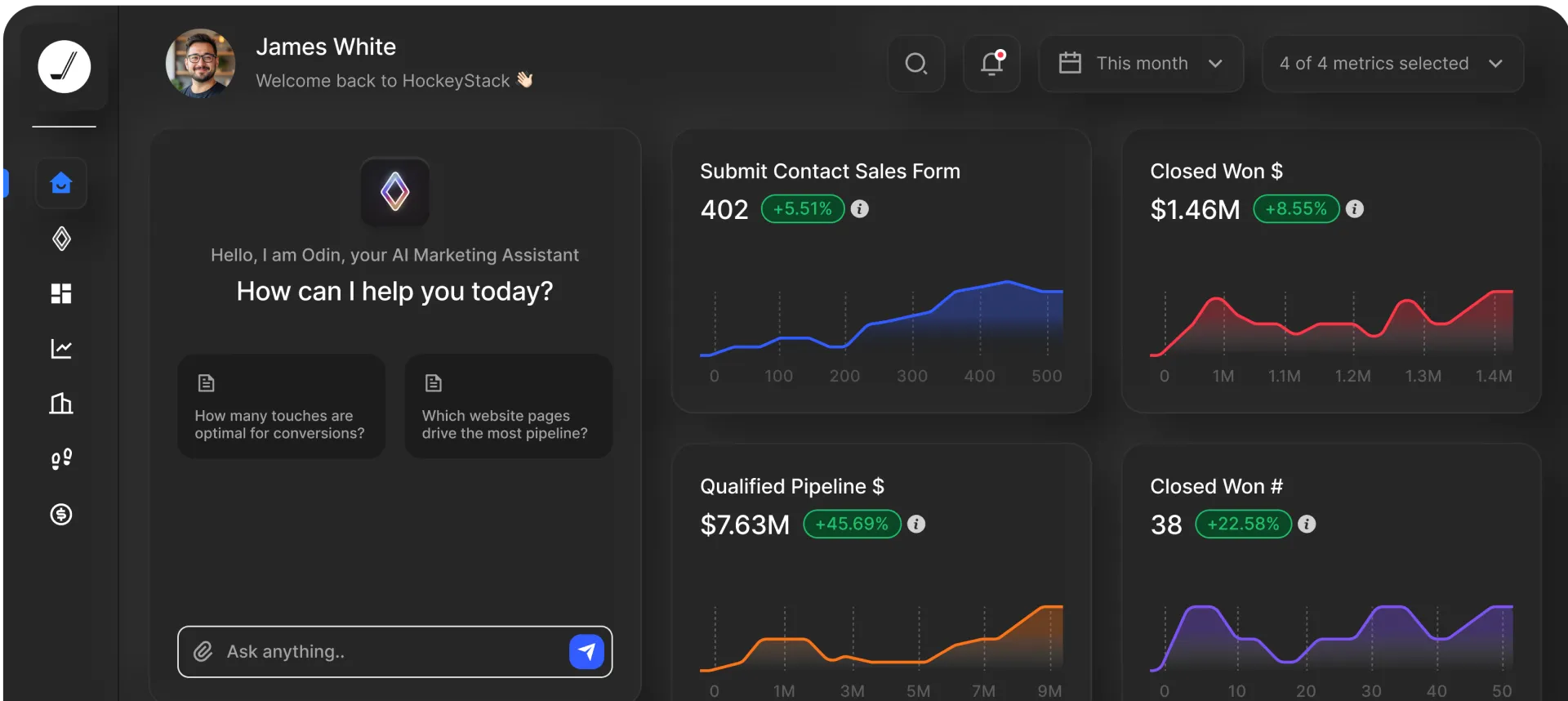
Ready to See HockeyStack in Action?
HockeyStack turns all of your online and offline GTM data into visual buyer journeys and dashboards, AI-powered recommendations, and the industry’s best-performing account and lead scoring.



